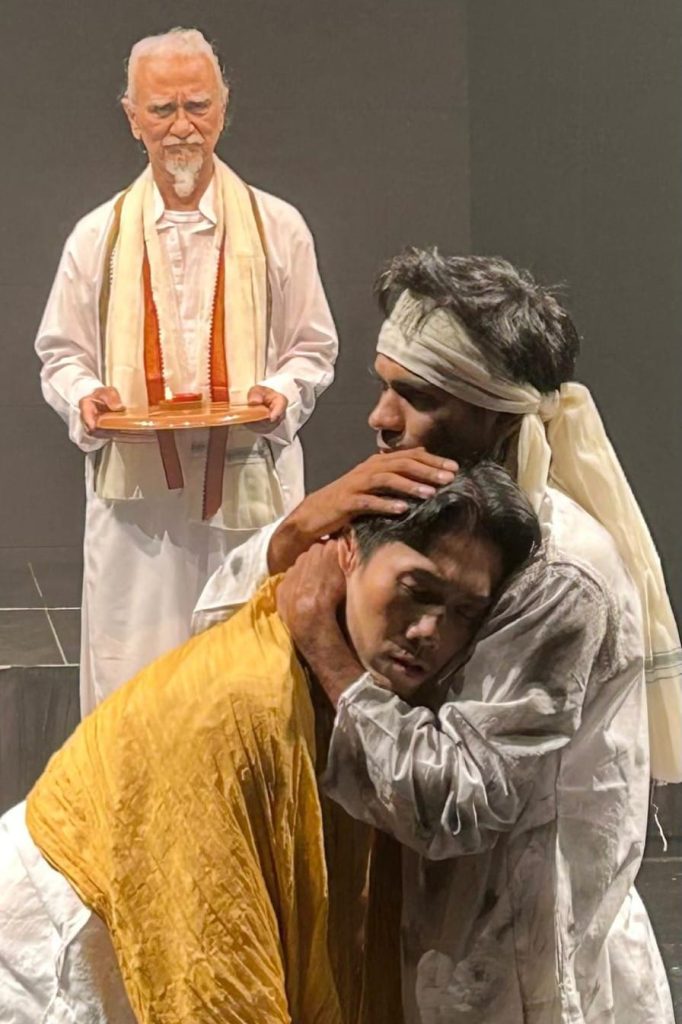Review of Siddhartha staged by World-in-Theatre, 1st December 2024
by Edmund Teo, 15th December 2024
Siddhartha is an important and significant story to be staged, and it is timely that World-in-Theatre has done so again after its first run in 1997.
A young friend frequently exclaims to me that “Life is tough.” While her lament relates to events in her personal and professional life, her sentiments resonate with many of us who feel unsettled by our own life challenges and troubling world events. Siddhartha offers a space for deep personal reflection on what, why and perhaps how we can live.
Based on Herman Hesse’s novella published in 1922 set in 6th century India B.C.E., the play centres on a Brahmin’s spiritual journey of self-discovery and search for enlightenment. The story, with allusions to Siddhartha Gautama’s (the Buddha) own path to enlightenment, is a philosophical quest for an answer to life and life experiences.
Staged in a Black Box setting with little more than three chairs and a small raised platform on one end of the space, the play relied on the gestures, positions, movements, dialogues and music to tell a compelling story. The directors used the space powerfully to convey the intimacy and tensions between the characters as the story unfolds. The play opens with Old Siddhartha (Philip Marcelo) setting the stage for the story and he remains present in various scenes as a silent mirror to the young Siddhartha (Akshay Sharma), a visible cue to the audience of how past, present and future are collapsed into the same space. While Hesse uses the river in his story as a metaphor for the melding of time, the directors, Elizabeth De Roza and Sonny Lim, have translated this metaphor on stage by having Old and Young Siddhartha occupy the same space. The recurring encounters between Siddhartha and Govinda (Lim Junjie) and how each encounter marks the changing dynamics between them as well as their spiritual progress are credibly enacted in the stage direction.
As with previous World-in-Theatre productions, music and classical Indian Dance are integral elements of the story used for visceral effect. The music (Danny van Noort and Angeline Tan) enhances the theme’s spiritual feel while the sensuality of Kamala (Priya Arun) and seduction of Siddhartha are conveyed through Bharatanatyam Dance.
The role of Siddhartha is tremendously difficult given how his character changes with time and in each exchange with the other characters, but there were poignant moments in the Father-Son scenes, especially when Siddhartha finally felt and understood his father’s loss through the own loss of his own son. Sonny Lim was transcendent in his portrayal of the Father. The Father’s words early in the play, “It is not disappointment I feel. It is loss” spoken to Siddhartha when Siddhartha left him to join the Samanas, comes full circle when Siddhartha experiences the grief of losing his own son. Credit goes to Andrew Mowatt who had to take on the very different character roles of Elderly Samana, Gautama (Buddha) and Kamaswamy in the 90-minute production.
The play remained faithful to foregrounding the central motif of Siddhartha, the refrain “I can think, I can wait, I can fast” recurring at various points in Hesse’s text. It is this principle and practice that drove Siddhartha through his spiritual journey through the phases of detachment, attachment and eventually to the enlightened posture of compassionate non-attachment. The production has to be commended for conveying accurately the message and spirit of Hesse’s text.
An Eastern Philosophy story written by a German in the early 1920s, staged by a Singapore theatre company comprising a multi-racial cast, World-in-Theatre’s Siddhartha transcends the cultural, geographical and temporal dimensions because it addressed an important universal human theme, the need for a way to live with, through or perhaps above the vicissitudes of life events.
Siddhartha is World-in-Theatre’s final production and we will be poorer for their absence. But in keeping with the spirit of the story, we can think, we can wait, we can fast.
